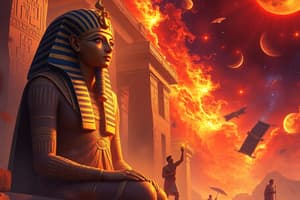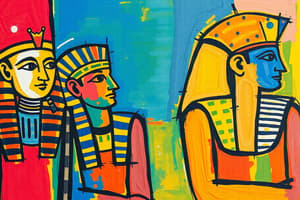Podcast
Questions and Answers
What is the main societal feature of the Old Kingdom?
What is the main societal feature of the Old Kingdom?
- The reign of pharaohs such as Hatshepsut, Akhenaten and Tutankhamun.
- The establishment of the Egyptian state and a social structure. (correct)
- Territorial expansion via military campaigns in Libya and Syria.
- A decline in the power of pharaohs due to political crises.
Which of these pharaohs ruled during the Middle Kingdom?
Which of these pharaohs ruled during the Middle Kingdom?
- Hatshepsut
- Mentuhotep II (correct)
- Ramses II
- Khufu
Which best describes the nature of Egypt's territorial involvement during the New Kingdom?
Which best describes the nature of Egypt's territorial involvement during the New Kingdom?
- They exerted a considerable amount of military force into Libya and Syria. (correct)
- They lost control of Nubia and focused their efforts on building pyramids.
- They experienced significant political instability, leading to a reduction of power
- They were invaded by the Assyrians, Persians, Greeks, and Romans.
What event marked the approximate end of the Old Kingdom period?
What event marked the approximate end of the Old Kingdom period?
Which period saw the most foreign invasions in Ancient Egypt?
Which period saw the most foreign invasions in Ancient Egypt?
Flashcards
Middle Kingdom
Middle Kingdom
A period of Egyptian history marked by resurgence and power, with pharaohs strengthening their authority and expanding the empire's territory. It also saw military conquests in Nubia, Libya, and Syria, demonstrating Egyptian dominance.
Old Kingdom
Old Kingdom
The foundational period of ancient Egyptian civilization, characterized by the consolidation of the state and the establishment of absolute pharaohs, who were seen as divine rulers. This era also saw the construction of the iconic Pyramids of Giza.
New Kingdom
New Kingdom
The golden age of ancient Egypt, distinguished by its splendor and magnificence, characterized by prominent pharaohs like Hatshepsut, Amenhotep III, Akhenaten, Tutankhamun, and Ramses II. This period witnessed the peak of Egyptian power and influence.
What was the role of pharaohs in the Old Kingdom?
What was the role of pharaohs in the Old Kingdom?
Signup and view all the flashcards
What caused the end of the Old Kingdom?
What caused the end of the Old Kingdom?
Signup and view all the flashcards
Study Notes
Periods of Egyptian History
- Two kingdoms formed around the Nile in Lower and Upper Egypt
- King Menes united the two kingdoms around 3100 BC
- Three periods: Old Kingdom, Middle Kingdom, New Kingdom
Old Kingdom (3100-2050 BC)
- Foundations of the Egyptian state and society were established
- Pharaohs were considered gods, holding political and religious power
- Pyramids of Giza were built during the reigns of Khufu, Khafre, and Menkaure
- Political and social crisis around 2200 BC ended the period
Middle Kingdom (2050-1580 BC)
- Mentuhotep II was the first pharaoh
- Pharaohs' power increased during this era
- Significant territorial expansion, conquering Nubia and launching campaigns in Libya, Syria
- Political instability allowed foreign invasions
New Kingdom (1580-31 BC)
- Period of splendor with pharaohs like Hatshepsut, Amenhotep III, Akhenaten, Tutankhamun, and Ramses II
- Egypt conquered Libya and Syria
- Foreign invasions (Assyrians, Persians, Greeks, Romans) from 1100 BC led to Egypt's decline
Studying That Suits You
Use AI to generate personalized quizzes and flashcards to suit your learning preferences.




